The quest for better handgun sights isn’t all that different from the quest to create a better mousetrap. There are myriad companies — aftermarket and OEM — manufacturing sights of almost every design imaginable. But nearly all of them have the same goal; the most rapid sight acquisition possible while retaining acceptable accuracy. For the last few months I’ve been playing with a set of Delta 1 Sights from Gun Pro — available for GLOCKs and 1911s, with M&P sets coming soon — and it’s high time for the review. . .
That lead photo is a bit of a spoiler, since it shows the unique sight picture — and it’s fair to say that’s the “secret sauce” — of the Delta 1 sights. Of course, so does the product logo and I figured it was as good a way as any to get folks to click on a review for yet another aftermarket pistol sight option.
Both sights are milled from steel. The front sight is similar to a standard sight blade, but it has a deep “V” notch cut into the top. The front of it is enameled in neon orange.
The rear sight is low profile and snag-free, with a delta-shaped (aka a triangle or a pyramid, but we’ll call it a delta as in Delta 1 sights), neon green fiber optic piece at center, rear. 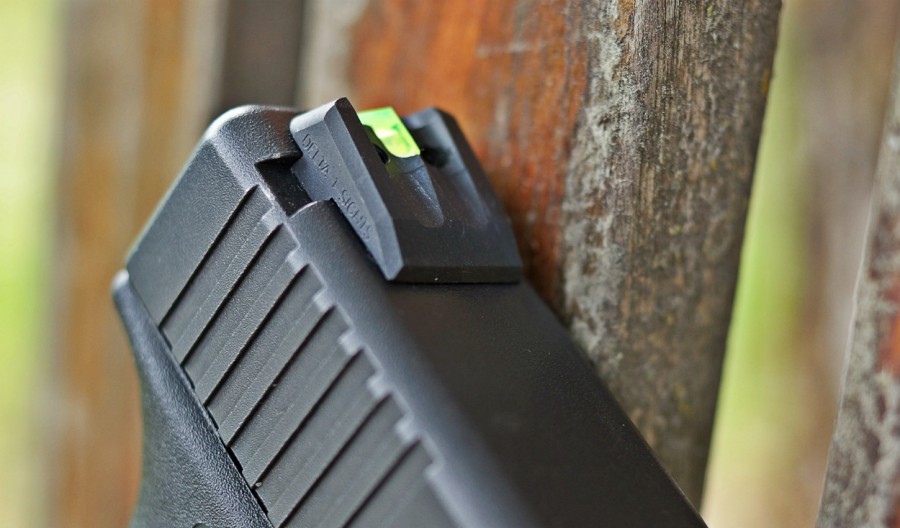
Instead of a traditional friction fit, two set screws lock the rear sight in place.
At least that’s the theory, as usually set screws like this indicate a sight that can be adjusted for windage by hand. In my example, though, the rear sight would have required a decent amount of filing before it would have fit in the dovetail and been able to slide left or right without massive amounts of force. As it was, this sight’s actually a bit tight even for a friction fit and, as I don’t have a GLOCK sight pusher, I had to beat it like a red headed, 3-legged, rented mule with Tourette’s.
Assuming successful installation, then, the idea behind the design is to improve sight acquisition as well as alignment precision through greater simplicity. It may look like there’s a lot going on here — lots of color and angles — but the result is “a single point sight picture” (I think that’s the “1” in Delta 1). Touch the top point of the rear delta to the bottom point of the front “V” and you’re aligned.
The image above is of the first design version, but as you can see in this review’s lead photo at top, version 2.0 is even more open and blocks even less of the view downrange.
While most of us probably don’t think of aligning standard sights as particularly complex, when put in the context of explaining the process to a new shooter, it certainly involves a lot more than “touch the top of the green pyramid to the bottom of the orange ‘V’ and the bullet impacts right at that point” (as though it’s a marble that has fallen to the bottom of the “V”). With standard sights, the shooter has to find the front sight and get it in the rear notch, vertically align the tops of the front and rear sights (or, when relevant and at some shooters’ preference, align the 3 dots), and horizontally align the front sight inside of the rear notch. In some cases the bullet impacts right on top of the front post, in some cases behind the front post (behind a front post dot, typically), and in some cases a distance above the front post.
That really is a lot more complicated and requires more mental power and focus on multiple places (along the tops as well as inside of the notch) than simply touching two points to each other. If nothing else, I do believe the Delta 1 setup will be simpler to teach new shooters on and will produce better results right off the bat.
On The Range
Gun Pro suggests that it takes something like 40 rounds for shooters used to traditional sights to start getting used to this new method of sight alignment. In slow fire, I shot the Delta 1 Sights almost as accurately as the factory Glock sights right off the bat. Aligning the two points is simple, and it just took a bit of time to get used to sinking the intended point of impact into the “V” notch consistently.
Rapid sight acquisition took me a few mags to get comfortable with. Once I was there, raising the pistol from the low ready and putting 10mm holes on targets happened about as quickly and as accurately as with the factory sights. Transitioning rapidly from target to target happened about as quickly and as accurately as with the factory sights.
What I came to find after shooting this setup more and more was that tracking the front sight blade is easier than normal, which is no surprise considering it’s quite tall and it’s neon orange, plus the rear sight blocks less of your view. Focusing on the front sight like you’re supposed to is also easy, as it draws your eye’s attention much more so than the light green, translucent rear sight does. On traditional sights, the front is often identical in color and general shape (i.e. 90* corners and straight lines) as the rear sight and is only visible inside of a small notch, so finding it and maintaining focus on it is definitely more difficult.
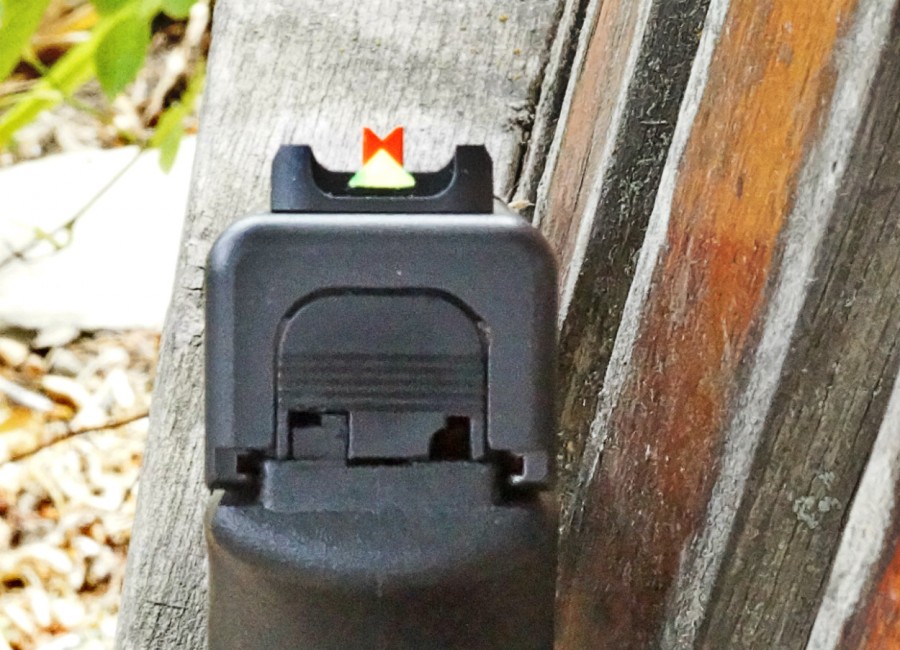
This allowed for two things that helped me shoot very quickly but with acceptable combat or USPSA-style accuracy…
First, inside of 15-or-so yards I basically ignored the rear sight’s alignment, caring only that I could see at least a smidge of green somewhere on top of all of that orange, and just tracked the front sight target-to-target and made hits. Not particularly different from rapid, multiple-target shooting with standard sights, really, but it’s easier with the Delta 1s because of how visible that front blade is compared to the rear, and how very open the rear sight is.
Second, for a long time now consensus has been that focusing on the front sight blade — everything else is as blurry as it needs to be depending on your eyesight — nets the best shooting results. A few sight designs were intent on changing that practice so, instead, the target can be the focal point and the sights basically superimpose themselves on top; actually designed to be viewed “blurry” in the foreground. I think the Delta 1 Sights are capable of this style of shooting, mostly because of how large and visible that front sight is, but also because the open and bright, yet translucent, rear sight means I can easily maintain rear-on-front alignment even when focused on a distant target instead of on the front sight.
Conclusions
Honestly, I’m probably not the best person to test out these sights since I really haven’t been able to commit to getting completely used to them. I’ve had 6 handguns in for review since I installed these sights on my GLOCK 20, and they all have standard-style sights. Going back-and-forth isn’t doing the Delta 1s any favors.
That said, I’m faster with them — with the same accuracy — as with 3-dot or all-black standard sights (or factory Glock sights). I’m about the same with them as with irons where the front sight stands out, either because it’s a fiber optic or it has a dot but the rear is plain, etc. But I’ve been shooting standard sights forever, so I think this actually says a lot given the limited experience so far with the Delta 1 Sights and the fact that I haven’t been able to commit exclusively to them to really dial things in.
Complaints would be the rear sight’s overly tight fit in the dovetail, and that the sights don’t really “go together” in that the rear is low-profile and snag-free for carry, but the front is gigantic and practically dead square. It may work just as well if, from profile view, that front blade were essentially delta-shaped, which would also make it at least snag-resistant for drawing and holstering. They sure are tough, though, as that rear shrugged off a hell of a beating.
They’re staying on my G20SF, which is my woods carry gun, and I’m confident they’ll shoot minute-of-bear as quickly as I can bring the gun to bear (in more ways than one).
Specifications: Gun Pro Delta 1 Sights
Material: steel; appears parkerized. Green fiber optic insert in rear, neon orange painted or powdercoated front.
Models: Available for GLOCK, which are fixed sights as seen here, and 1911 Novak cuts, which are fully adjustable. S&W M&P coming soon.
MSRP: $89 for GLOCK (fixed). $119 for 1911 (adjustable)
Ratings (out of five stars):
Overall Rating: * * * *
If the rear sight allowed for by-hand windage adjustment, which I think it’s supposed to, and the front was maybe sleeker in some way (at least angle the front of it rearwards, maybe), I’d likely be giving the Delta 1 Sights five stars. They’re simple, stout, and very effective in that they allow for rapid acquisition and fast shooting with solid accuracy. I also like how simple the sight picture is and feel it would be easy to train new shooters with them.



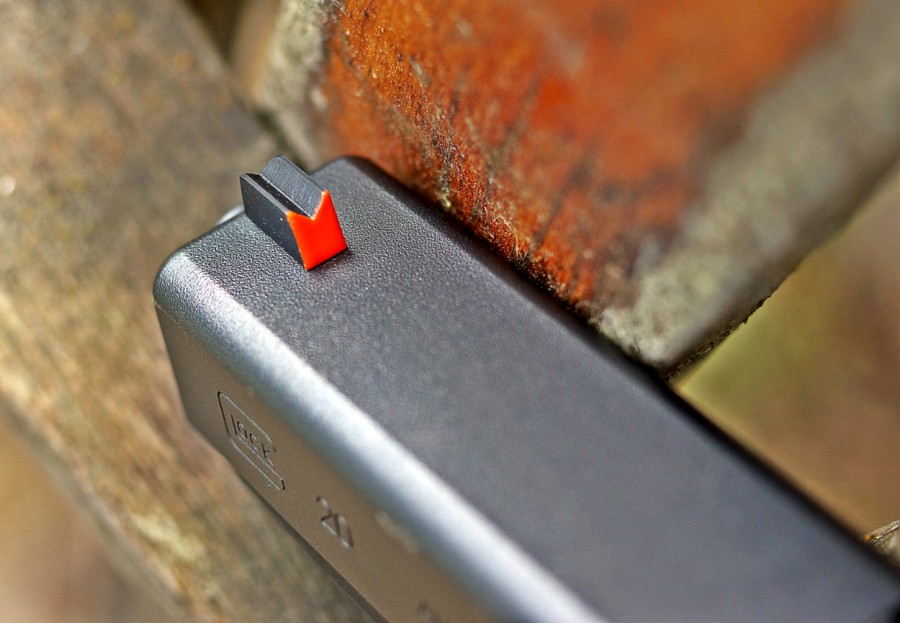

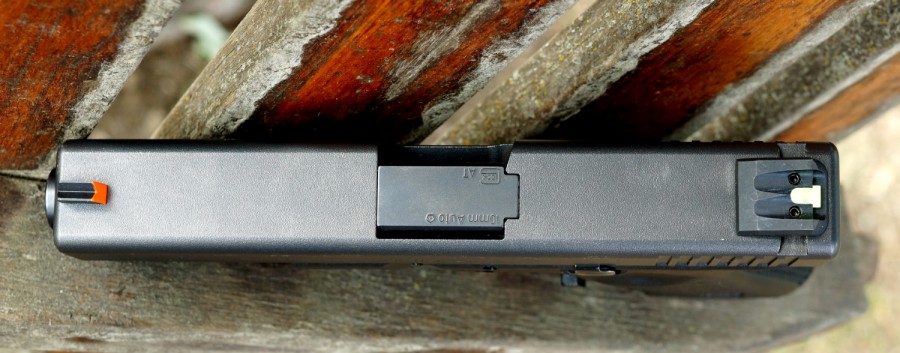
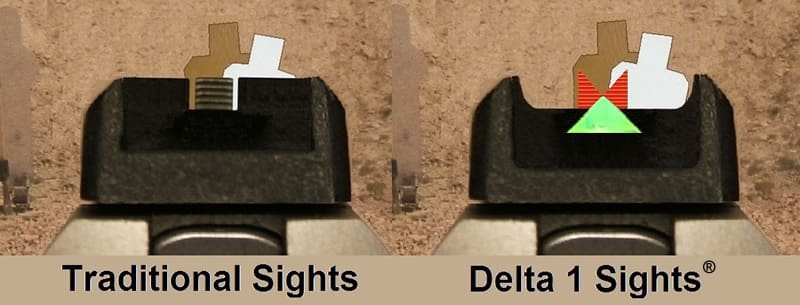
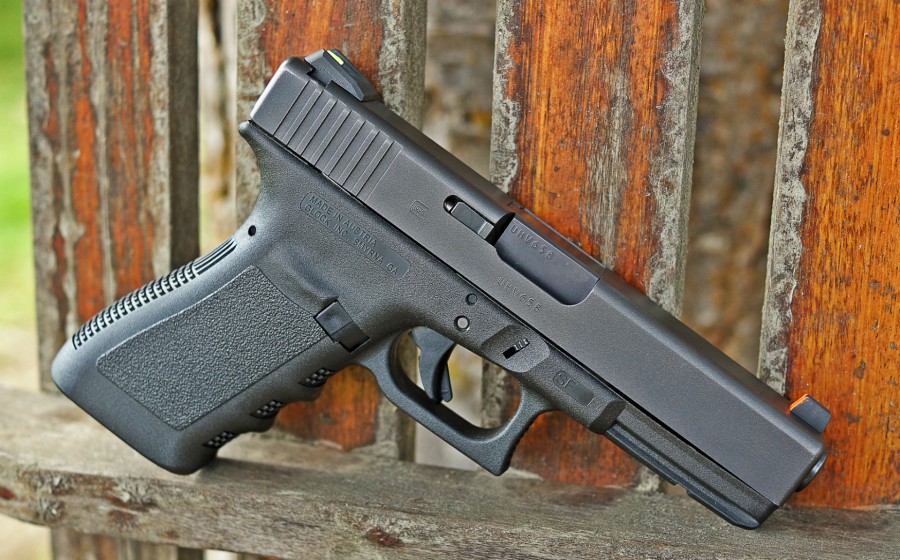




The sight picture is too busy for my eyes. I’ll stick with Trijicon HDs or Ameriglo I-Dot Pros on my defensive handguns.
The one thing I like about my XS sights is that the front dot glows in the dark, which comes in handy in low light conditions. They may want to add that.
How about instead of using the traditional .125″ W rear, with a .125″ W front, and a “combat” sight picture hold.
Why don’t they show what most higher level competitors use. .125″ W rear with a .100″ W front, with it zeroed so the POI is right on top of the front sight blade.
If POI were on top of the front sight blade you’d be doing more left-right centering estimation and effort. Putting your intended POI at the bottom of a V shape (like a marble falling to the bottom… the bullet hole would be visible right there at the notch; it isn’t obscured by the front sight) takes care of both left-right and vertical alignment very easily and intuitively. Also touch the top of the green “delta” to the very same point and you’re 100% lined up. As they say, it’s a “simple single point sight picture” and part of that is ensuring that POI is right at the exact same single point also. It really is a lot less to think about and a lot less to focus on than with normal sights where you have to align up/down, left/right align the light gaps on either side of the front blade in the notch, and then either obscure your POI with the front sight or hold the entire blade underneath your POI, etc. This all happens pretty quickly for anyone who’s been shooting for a while, but I think more experience with the Delta 1s would prove they’re faster for me and I’m totally positive they’re significantly faster for a new shooter to pick up. Faster or not, I think I forgot to mention that I’m a better two-eyes-open shooter with these than normal sights.
Two eye open shooting should be easier just because of the brightness and contrast of colors between the front and rear sight. Nothing against the single point design, wouldn’t judge it without actually trying it, but sights like the truglo TFOs might have similar performance.
I’ve shot those and lots of other fiber optic combos with different front/rear colors, etc. I think something about how these sights have the rear overlap the front instead of sit along both sides of it makes it easier for me. Like the reason some people really love the Straight 8 sights. There are two objects (one front, one rear) instead of three (one front, two rear either because there are two dots or two sides to the sight). You do also see more of the target because the rear is on top of the front sight instead of blocking the view on either side of it.
Huh? Left right estimation? The brain is naturally attuned to centering things, getting the front sight centered in the notch is easy. Same with lining the stop of the notch and the post. By setting up your POI so it is at the top of the front sight blade, you see where your shot is going to hit.
People needlessly complicate things. Except for extremely hard or easy targets, keep your focus on the front sight and you brain will do the rest.
You mention USPSA. USPSA shooters will do virtually anything to shoot gooder. Some would sell their own mothers in servitude if it meant shooting faster and more accurately. Yet virtually everyone uses the notch and post sights with at most a fiber optic insert. No one uses these gimmick sights because they don’t want.
I can think of a dozen of the gimmick sights that people I’ve known tried. Every single one goes back to notch and post.
I’ve never considered deviating from a plain black rear and fiber optic or otherwise highly-visible front sight for my target / competition pistols. That has always performed best for me, hands down. However, I could see moving to these for competition and self defense if night sights are not specifically desired for that purpose.
Interesting approach.
Since I can’t focus on a front sight without my reading glasses (which I probably won’t have on in a DGU situation), and since we’re told the natural response to a deadly threat is to focus on the threat, I have been trying to train as I fight, which means focusing on the target. While this approach may limit my group size, it makes sense to me.
So the next question becomes: What sight design works best if you’re focusing on the target? The three dot design sounds good, since a person should be able to line them up even if they’re blurry. But I might have to try this Delta 1 concept.
With both eyes open and focus on the target, these sights align easier and more precisely than any other iron sights I’ve shot. I can still quickly get the top of the green on the bottom of the orange V and they don’t obstruct much of the downrange view.
These sound cool. I’d be willing to give them a shot, but I’m thinking XS big dots would still win for me.
Same thoughts. I would not pass up an opportunity to try them and pretty sure I will at some point but I share the prediction. I would actually be happy to be wrong and find that these sights or any other irons offered an improvement in acquisition speed (for me) over XS Big Dots. My personal experience with the XS sights was no real learning time and no issue going back and forth between them and a traditional 3 dot sight picture. I imagine it would be the same with these.
These sights remind me of those found on the Steyr M9, minus the notched front post. Having used the M9 and found it’s sights very effective & easy to use, the Delta 1 setup looks a bit over-complicated and not as intuitive…. but if they were any closer in design it’d probably infringe on Steyr’s patent.
If I could put the Steyr sights on my pistols, I’d do it in with a quickness.
But the Delta 1? Eh, not so much.
I find these easier & faster to align than the Steyr pyramid sights.
I put Advantage Tactical Sights (also reviewed on TTAG) on my Sig 320 and was very impressed. Any thoughts on how those compare to Delta 1? It would be really cool if TTAG did an “aftermarket sight comparison” similar to the ones I’ve seen on muzzle devices, etc.
I’d volunteer to help, but the only aftermarket handgun sights I own are the ATS. I DO like them a lot more than irons. I’m faster and more accurate (which isn’t saying a lot, but it’s saying something 🙂 ).
I don’t see it as a single point alignment like these. You’re working to align the bottom & sides of that front sight in the notch in the rear sight (centering one object left/right up/down inside another), and if you’re focusing where they touch then the target is well above that point. What’s unique about these is that you’re just touching two tips together and that’s also where the bullet hits and you can see the target there as well.
It doesn’t matter what sights I have, I can miss just as fast with any of them.
On a more serious note, rather than searching for the “perfect” sight system, why not find something that’s acceptable and practice a lot?
I shoot with iron sights on my 1911’s. Single white dot front sight on my Kimber and a 3 dot system my Sig.
I’m good out to 25 yards with what I have, however, I have practiced extensively with both firearms. I’m almost as good with my GI Model RIA 1911. And the only reason I’m not as good with the RIA is that I do not shoot it nearly as much as my other 1911’s.
It may seem dull, but practicing with the same firearm regularly under various conditions will get one further than continuously changing sights and or firearms in a quest for the “perfect” system.
Meh. I’ll stick with Trijicon HDs. Also tried XS Big Dots but loathed them. To me, pretty much anything other than traditional sights on a pistol (not including optics) is a gimmick, trying to solve a problem that doesn’t exist. No need for silly notches, dashes, shapes, or 15 different colors.
We may call them “traditional” sights, but they’ve darn sure evolved a lot. We didn’t even see the 3-dot system until the HK P7 hit the market in 1980 or so. Heck, for most of the history of the pistol the sights were either non-existent or nearly impossible to see and one-handed, no-sights shooting was the training method for defensive shooting. Then came the teacup hold and weaver stance and it was still often all point shooting. I don’t know when front sight focus became the standard and sights began to change to suit that style, but it wasn’t that darn long ago and the “traditional” sight has always been in a state of flux anyway. Point being, whether the Delta 1s are a step in the right direction or not, I definitely don’t think we’ve run out of room for innovation or improvement! Forgetting the colors and appearance, shapes, size, etc of these sights, the concept of single-point alignment is spot on. It’s absolutely quicker, easier, more intuitive than “traditional” alignment.
If only someone would release guttersnipe sights for a Glock akin to those found on the ASP.
All dovetail sights are going to require a little stoning to fit properly – do yourself a favor next time instead of pounding and cursing the sight in (been there) use a stone on the bottom of the sight dovetail until it fits halfway into the slide without pounding, then tap it the rest of the way and tighten the set screws.
It required a file. I installed it twice — the first “as-is” for the purposes of reviewing out of the box, as it was supposed to fit — and took it down with a metal file quite a bit before it even friction fit properly. And, no, they don’t all require filing or stoning to fit right. Sights that use set screws to hold them in place have become fairly popular and the entire point is that they do not friction fit in the dovetail and can be easily drifted by hand. Like the OEM sights on the Beretta Nano that I EDC.
3 dot sights kinda suck- you’re supposed to align the top edges so what’s the point? Just more thingies to confuse the brain.
A FO front with black rear is what all the “good” competitor shooters use. For night time, a tritium front with black rears is a good option.
What bugs me (well, one of the things) about these sights in this article is that the rear is FO, so it is likely brighter than the front, drawing your eyes to the wrong focal point.
I think the concepts used in this sight are good. I vastly improved the “sights” on a Taurus PT 738 with the brightest day-glo yellow paint I could find on the front sight and a contrasting red-orange nail polish on the rears. I later replaced them with the little NiteSighter dots, which I believe are better. At least for me the color contrast is a really good idea but with the brightest one at the front, as clickboom said above. I am surprised that some of the major sight manufacturers have not engaged optometrists or ophthalmologists to run controlled tests on which shapes/colors can be picked up quickest, or which promote greatest accuracy.
Agreed on scientific testing part. Reminds me of this awesome article from Shooting Sports USA (link is to online version of the print mag): http://www.nxtbook.com/nxtbooks/nra/ssusa_201108/index.php#/20
…and here’s a listing of other, similar articles related to eyesight and shooting: http://www.starreloaders.com/edhall/nwongarts.html
btw — my take on the rear is that it’s lightly colored and fairly translucent so it’s kind of like a “ghost” on top of the front sight and it’s hard to actually focus directly on it because of its translucency. The darker color of the front also seems to draw my eye to it. But, back to the scientific testing, I’m sure people vary in this. Of course, Delta 1 does suggest these sights can be shot with focus on the target, not on either sight at all, and I think they really do work that way quite well and I intend to shoot them that way more.
I was looking at these the other day. They seem interesting enough, but I wasn’t sure about all that loud color in my focal plane. I also wasn’t sure about the idea of switching between sights like these, and the industry standards that I am getting on T&E guns. I’m just not sure I would want to swap out between different sights if I pick up a different gun. I have to put out a box of lead just to adjust between 3 dot and straight 8. So I am glad that you pointed out the very stark difference possibly being an issue. (Even if indirectly)
It hasn’t caused me any issues going back to normal sights. Just too used to them I suppose and I’ve also become used to shooting with different sights on different guns nearly every weekend anyway. I just feel like I’m almost certainly leaving performance — speed & accuracy — with the Delta 1s on the table by not being able to fully commit to them for a while. I ran an IPSC-style stage on the very first day I installed and shot them after putting only three mags through the gun and scored right where I normally would. I feel like I’d improve from there but the next few times I went shooting it was with normal sights and then back to these for a couple hours then normal sights again… they’re easy and intuitive enough that there isn’t much of a learning curve at all, but I know I’m far from as proficient as I could be with them if I was closer to exclusive with them or simply had a lot more time behind them in general.
I think this sight is too busy. The original Glock sights work well and any other 3 dot ones work just as well for me. I think lining up 2 triangle vertices would take too much time. Just my thoughts, though.
+1 for using a the Glock 20.
I wonder if the front sight could be re shaped, or contoured without damaging the sight, or would it even be worth doing.
I’m not opposed to modifying.
Have been known to fix something till it’s broken…